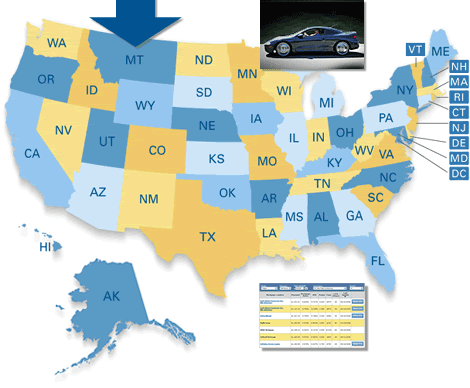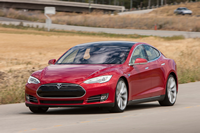The Return of Electric Cars: How An Old Favorite Made a Comeback
by Amy Lillard
(4/2/2013) In the last few years, electric cars have been making news. Long considered the stuff of futuristic science fiction, these types of cars are providing important alternatives to consumers. Many car buyers and enthusiasts are surprised to discover, however, that this is actually the second time electric cars have invaded the automotive market. How were electric cars developed, and what does the future hold for them?
Beginnings
Several different inventors have been given the credit for the first electric car. Whether it was in founded in Hungary, Scotland, or Holland, the beginnings of the electric car happened around 1830, with major improvements to the design and the battery over the rest of the century. By the late 1800s, electric cars were being sold and used regularly in France, Great Britain, and eventually the United States.
While American consumers could choose between steam, electric or gasoline-powered cars in 1900, the electric vehicle far outsold them all. The popularity was due in some part to the poor quality of roads outside of towns and the difficult nature of shifting and starting other cars. Electric cars thrived in local commuting, and far outshone steam and gas cars in ease of operation.
But as decades passed, electric cars waned in popularity. The national, intra-and interstate road system improved dramatically, and consumers needed vehicles that had longer range. Gas prices dropped significantly after Texans struck local oil deposits, making it much more affordable to drivers. Gas-powered cars improved in design, with electric starters replacing awkward and difficult hand crank starters. And these were the cars that began to be mass produced at Ford factories, reducing the price to affordable levels.
All of these factors resulted in the removal of electric cars from the market by World War II.
Resurgence
Gas-powered cars became the most convenient and cost-effective choice for auto consumers in the first half of the 20th century. But in the second half, a growing group of consumers began to examine the effects of these types of cars on the natural and political environment.
In the 1960s and 70s a growing social movement looked at the dangers posed by pollution. The environmentally minded activists pointed to exhaust emissions from internal combustion engines as a major problem for environmental sustainability, and began the call for alternative-fueled engines. At the same time, political unrest in the Middle East, which provided the majority of crude oil fueling Western engines, lent credence to this growing call for an alternative to gas vehicles.
Over the next decades, numerous companies made the first fits and starts with modern electric vehicles, producing different models at high price points but low speed and ranges. By the 1990s companies had encouragement in their efforts as the federal government passed more stringent air emissions requirements and regulations in gasoline use.
At the beginning of the 21st century, electric cars had advanced in design to increase potential usage. When Toyota brought the hybrid Prius model to the U.S. in 2000 in US, it met a market primed for a new type of car. And it set a precedent that non-gas-powered cars could find buyers.
Mass Adoption
Today several factors are working together to make electric cars a truly viable alternative for car buyers.
• Advances in batteries and power management. One of the major restricting factors behind mass adoption of electric vehicles has been the relatively limited range of the battery and the amount of time it takes to recharge. Currently most electric vehicles have a range of up to 100 miles, covering most consumers’ daily needs. Charging requires between 10-20 hours. However, there is a major effort behind the rapid development of more effective and efficient lithium-ion batteries, as well as faster charging technology. This advance by itself could be likened to the advancements provided by Ford’s method of mass production in the 1920s, and may be the trigger pushing electric cars over the edge and into more consumer homes.
• Concerns about oil prices. Volatile political climates increasingly mean skyrocketing imported oil prices and supply disruptions. Governments are looking for ways to reduce their dependence on foreign oil, diminish the exploitation of developing countries, and sever tenuous relationships with unfriendly foreign governments. Electric cars provide an answer.
• Environmental concerns go mainstream. Today scientists and the general public are much more accepting that global warming exists and is caused in part by greenhouse gas emissions. Consumers have subsequently incorporated a reduced footprint in many parts of their lives, including recycling, bicycling, and buying local. Electric vehicles are a natural outgrowth of this activity, since they do not emit harmful tailpipe pollutants. Many consumers are increasingly willing to justify the higher purchase price of electric cars with the long-term cost reduction and pollution reduction.
• Mass production driving down cost. For a long time, the higher cost of electric cars derived from the cost of the batteries. However, as more and more companies develop electric vehicle models, and demand increases, mass production is driving down these costs. That will only accelerate.
• Government encouragement. In recent years the Obama administration has created a number of incentives for consumers and companies to go “green,” including loans and grants, economic stimulus funds, and tax credits. They’ve also set forth a federal mandate to improve fuel efficiency in response to concerns over global warming and importing oil. When it comes to electric cars, a number of federal tax benefits are afforded to buyers, and efforts are underway to fund a public electric-car-recharging infrastructure and more cost-effective battery tech. In addition, individual states may offer buyers special deals as well. For example, Pennsylvania provides rebates of approximately $3,500, and New Jersey provides a sales-tax exemption.
As a result nearly every major car manufacturer has entered the electric car market, including Nissan, Ford, and General Motors. Numerous companies have started that focus exclusively on electric vehicles, including Tesla. There are now around 20 different models available to choose from, including the Tesla Model S, Ford Focus Electric and Honda Fit EV. The top-selling highway-capable all-electric cars as of December 2012 are the Nissan Leaf (more than 49,000 units sold worldwide) and the Mitsubishi i-MiEV (more than 27,000 sold worldwide).
When considering the future of electric cars, we need only look to the past. Whereas once gas-powered vehicles were considered too costly, inefficient, and inaccessible in comparison to electric cars, that quickly changed due to the confluence of major social, industrial and legal advances. Today, we’re poised for the pendulum to swing back again.
Other related articles:
Top 5 Reasons to Buy an Electric Car
Electric Cars: Is it Right for You?
Electric Cars: Buying Considerations
Electric Cars: Top 5 Things to Know
Automotive Loans: Determining a Down Payment
Automotive Loans: The Truth About "Add-Ons"
Automotive Loans: Negotiating a Loan with a Dealer
Automotive Loans: How Much Car Can You Afford?
Automotive Loans: Applying for a Car Loan
High MPGs and low auto loan rates can save you thousands of dollars
Research your options when shopping for an auto loan
Closed End Lease or Open End Lease
New and Used Auto Loan Rates
Choose Your State Below

Start by selecting your state

Amy Lillard
The ERATE® Resource Guide to No-Closing-Cost Refinancing
Principal Reduction: New Programs, More Controversy
Understanding Mortgages: Mortgage Paperwork
Understanding Mortgages: Types of Mortgages
Understanding Mortgages: How to Get a Mortgage
Understanding Mortgages: Buy or Rent?
Understanding Mortgages: Working with a Real Estate Agent
Understanding Mortgages: Working with a Real Estate Agent

Automobile Buying/Financing
5 Steps to Find the Perfect Car
Auto loan defaults to rise 7 percent in 2010
Auto Show Season Tips for Buyers
Consumer Reports suspends recommendations for Toyota's recall models
When is the Best Time to Buy a New Car?
Making a Vehicle Purchase? Enjoy These Helpful Tips
Chances are, your next car will be used. Drive a hard bargain
What your car is really saying
2012 President's Day auto sales among best ever
Special Report: Hitting the Brakes on Auto Dealer Loans
Auto Insurance
Buying Ins - Shopping for Insurance
Best Car Insurance Plan for You


